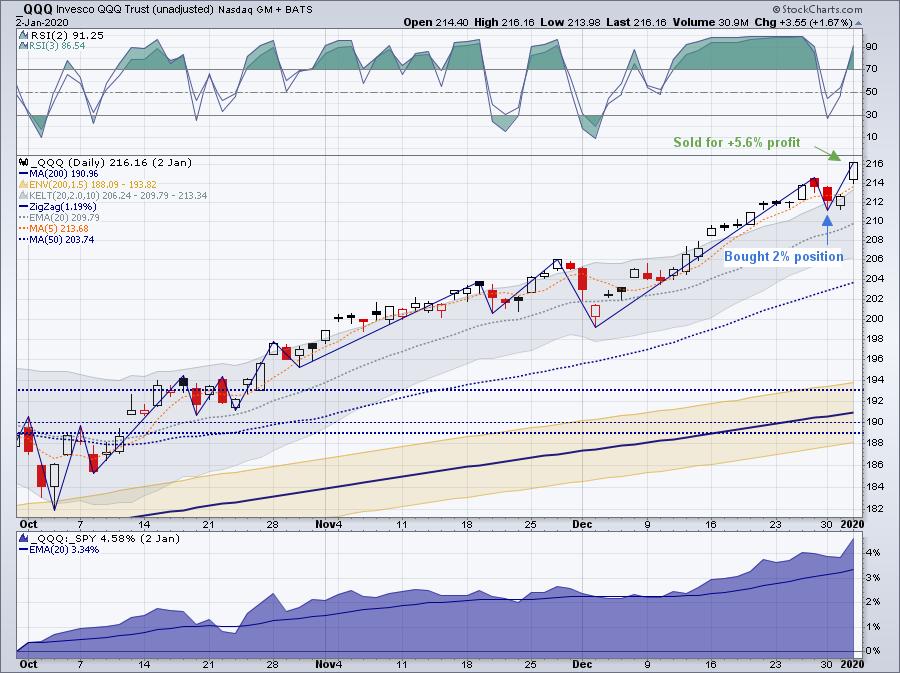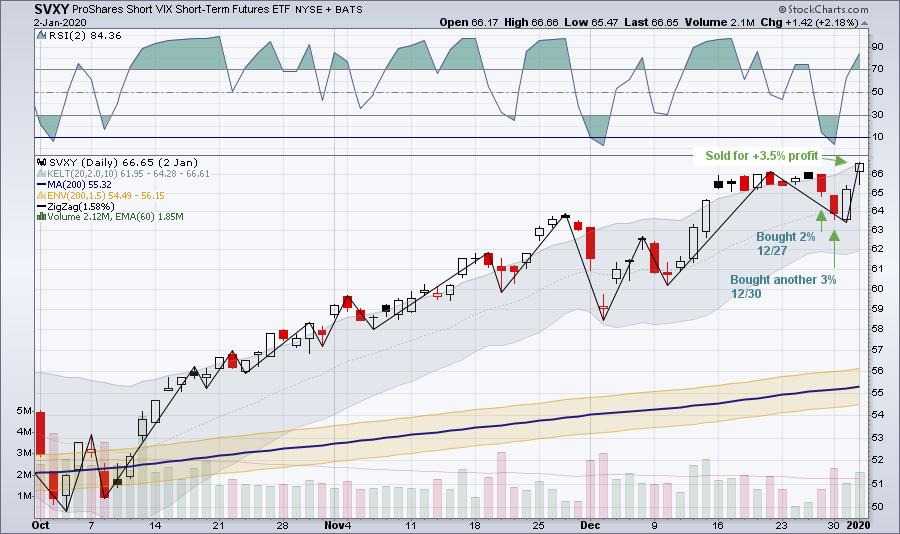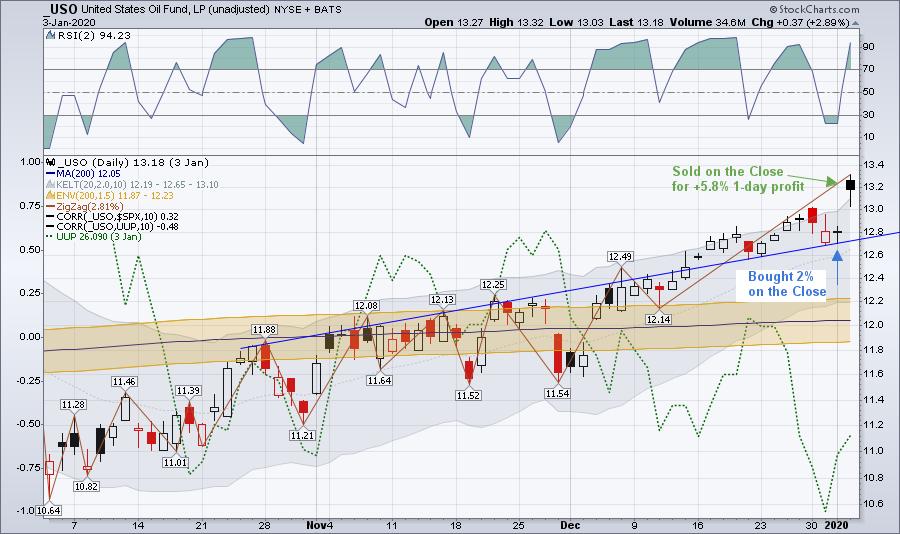
Editor’s Note:
The following is a guest post from Jack Loftis, PhD, founder of ETFswingtrader.net and long-time friend of Morpheus Trading Group.
So far this year, Jack is carrying an incredible 100% win ratio, with 14 wins out of 14 trades closed in his ETF swing trading service.
Check out his article below to discover exactly how he did it, and to learn more about the excellent ETF trading strategy he uses.
Putting My Money Where My Mouth Is
As we rolled into a new decade with “2020” appearing on my screens, I realized I have been posting results of my ETF swing trades for a full decade.
Are they still working?
The answer to that question lies in understanding exactly why I utilize this trading system, which has an average long-term win ratio around 90%.
In order to provide cash flow for my family, while continuing to increase my retirement account, I personally need to generate 2% profits on my entire portfolio every month.
By rigidly following the rules of my ETF swing trading strategy, I fortunately have been accomplishing that objective.
The results of my ETF trades, which I always share with my valued newsletter subscribers, have been contributing more than half of that monthly goal even on slow months.
Further, options trades based on these setups are still averaging a gain of +20% per trade (including all winning and losing trades).
This mean traders who are trying to build smaller accounts can also generate excellent percentage returns by substituting options trades for my ETF swing trades.
So, the answer is a resounding “Yes!”–my trading system is still profitable, consistent, and effective.
Continue reading to see actual recent trade examples of trades that show how you too can start generating consistent profits from trading ETFs.
$TQQQ (Leveraged Nasdaq 100 ETF)
+5.6% Gain on 2-Day Hold
On December 30th, the ETF trading system I use generated a Buy Entry signal for $QQQ (Nasdaq 100 ETF).
Here is how the chart looked at the time:

On the top section of the chart above, notice the RSI indicator had dropped into oversold territory, while $QQQ was in the midst of a strong uptrend.
This triggered the buy signal in my “reversion to the mean” trading system.
Accordingly, I notified subscribers that we were entering the trade on that day’s close.
Two days later (January 2), the RSI had jumped into overbought territory.
This was our cue to take the quick profits, which yielded a solid +5.6% gain on a two-day hold.
By the way, notice that $QQQ actually did not rally 5.6% over two days (it was closer to 1.9%).
However, we executed the trade using $TQQQ, the 3x leveraged version of $QQQ instead.
Leveraged ETFs work great for the trading system I use because it is focused on seeking small, quick wins.
Of course, it is impossible to time every single trade so precisely.
As such, let’s next look at the outcome of a trade that moved against us right after entering it.
$SVXY (Inverse VIX ETF)
+3.5% Gain on 3-Day Hold
ProShares Short VIX ($SVXY) is an ETF that trades inversely to $VXX, an ETF that loosely tracks the VIX market volatility indicator.
$SVXY was the second trade we closed profitably on January 2, the first trading day of the the new year.
Our entry and exit points are annotated on the chart below:

We entered the $SVXY trade with a 2% position on December 27–yes, that’s 2% of my entire (large) portfolio.
If traded properly, $SVXY historically wins 97.5% and I actually took this trade in multiple accounts due to its track record.
On December 30, the next trading day after entry, the trade moved against us.
But based on the proven trading system I use, I methodically added another 3% position to the $SVXY trade–giving me a large 5% position.
Note that I allocate up to a maximum of 10% of my portfolio for each trade, since all my ETF trades historically win approximately 9 out of 10 times.
One trading day later (January 2), the ETF moved higher and I locked in a +3.5% profit on this large trade.
Again, it was a small percentage profit for a large dollar win.
$UCO (Leveraged Oil ETF)
+5.8% Gain on 1-Day Hold
After profitably closing two ETF swing trades on the first trading day of 2020, we noticed that $USO (Oil ETF) was also flashing a Buy signal.
Similar to the $QQQ trade, the RSI indicator was oversold while the ETF was in an uptrend.
This triggered a Buy Entry signal for an initial 2% position in $UCO (2x leveraged version of $USO) on that day’s close.
Our entry and exit points are shown on the chart below:

As always, subscribers of my ETF swing trading service were also notified at the time of entry.
Our timing was fortuitous because $USO zoomed higher one day later, enabling us to lock in a quick +5.8% gain on the $UCO trade.
$ERY (Inverse Energy ETF)
+4% Gain on 1-Month Hold
The three trades above were an excellent start to the year–but of course, not all my trades work out well so quickly.
Sometimes you just need to be patient (while always keeping your protective stop in place).
$ERY, an inverse ETF of $XLE (Energy ETF), is one such example.
This trade was the longest hold time of any newsletter trade, but I trusted in the rules of my proven trading system and gave the trade time to work out.
We bought a 2% position in $ERY on December 9, added 3% more on December 12, and added the final 5% on December 30.
We eventually sold $ERY for a +4% gain on January 21.
2020 Stats: 14 Trades, 14 Wins, 0 Losses
All my ETF swing trades (both winners and losers) are clearly tracked and reported to subscribers of my ETF swing trading service.
Below is a list of all the ETF trades (including two options trades) I have closed so far in 2020. Trades are listed chronologically, based on the date each trade was closed:
- $TQQQ +5.6% profit on 1/2
- $SVXY +3.5% profit on 1/2
- $UCO +5.8% profit on 1/3
- $BIB +2.1% profit on 1/8
- $TNA +4.4% profit on 1/14
- $KOLD +6% profit on 1/15
- $ERY +4% profit on 1/21
- $MJ put options +20% profit on 1/23
- $LABU + 4.1% profit on 2/4
- $SSO +3.3% profit on 2/4
- $NUGT +4% profit on 2/10
- $SVXY +2% profit on 2/11
- $GDX call options +27% profit on 2/19 (rolled over)
- $UNG put options +35% profit on 2/21
Learn More and Profit!
As you may have discovered from the examples above, the power of my ETFSwingTrader setups is that they identify high probability trades that can be profitably traded with a large percentage of your portfolio.
With these ETF trades being profitable 85-90% of the time, just imagine what an options version of each ETF trade could do for your account.
To learn exactly what an options trading account can do with these setups, check out my blog post, The Smallest Hedge Fund in the World.
In this article, I show you exactly what I did with $30,000 in IRA rollover money that I had in my account for 6 weeks.
Spoiler: +21.8% profit in 6 weeks. Includes official broker listing of all trades during that time.
I have been posting my ETFSwingTrader setups every day for the past 10 years–and plan to continue doing so for years to come.
This service provides you with about 10 trades a month, making it ideal for part-time traders who cannot watch the market all day long due to full-time jobs.
Average holding time is around 5 trading days.
I post parallel options trades for about half of the ETF trade picks.
Please e-mail me if you would like to receive a 3-page discussion of my simple options trading strategies with full trade records.
I am also happy to answer any questions about my trading strategy if you drop me a line ([email protected]).
Nobody knows what 2020 will bring, but one thing is certain–the concept of “reversion to the trend” will keep providing us with an infinite supply of high probability, tradeable ETF setups.
Regards,
Jack Loftis, PhD
